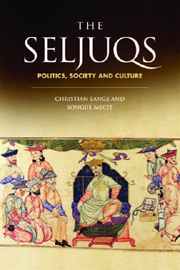Book contents
- Frontmatter
- Contents
- List of figures
- Acknowledgements
- List of abbreviations
- INTRODUCTION
- PART I POLITICS
- PART II SOCIETY
- 6 ARSLĀN ARGHŪN – NOMADIC REVIVAL?
- 7 CONTROLLING AND DEVELOPING BAGHDAD: CALIPHS, SULTANS AND THE BALANCE OF POWER IN THE ABBASID CAPITAL (MID-5TH/11TH TO LATE 6TH/12TH CENTURIES)
- 8 THE SELJUQS AND THE PUBLIC SPHERE IN THE PERIOD OF SUNNI REVIVALISM: THE VIEW FROM BAGHDAD
- 9 CHANGES IN THE OFFICE OF ḤISBA UNDER THE SELJUQS
- 10 AN EMBLEMATIC FAMILY OF SELJUQ IRAN: THE KHUJANDĪS OF ISFAHAN
- Part III CULTURE
- Index
7 - CONTROLLING AND DEVELOPING BAGHDAD: CALIPHS, SULTANS AND THE BALANCE OF POWER IN THE ABBASID CAPITAL (MID-5TH/11TH TO LATE 6TH/12TH CENTURIES)
from PART II - SOCIETY
Published online by Cambridge University Press: 12 September 2012
- Frontmatter
- Contents
- List of figures
- Acknowledgements
- List of abbreviations
- INTRODUCTION
- PART I POLITICS
- PART II SOCIETY
- 6 ARSLĀN ARGHŪN – NOMADIC REVIVAL?
- 7 CONTROLLING AND DEVELOPING BAGHDAD: CALIPHS, SULTANS AND THE BALANCE OF POWER IN THE ABBASID CAPITAL (MID-5TH/11TH TO LATE 6TH/12TH CENTURIES)
- 8 THE SELJUQS AND THE PUBLIC SPHERE IN THE PERIOD OF SUNNI REVIVALISM: THE VIEW FROM BAGHDAD
- 9 CHANGES IN THE OFFICE OF ḤISBA UNDER THE SELJUQS
- 10 AN EMBLEMATIC FAMILY OF SELJUQ IRAN: THE KHUJANDĪS OF ISFAHAN
- Part III CULTURE
- Index
Summary
Seljuq Iraq, though a central Islamic land and the heart of the Abbasid caliphate, has not received the full scholarly attention it deserves; in comparison, the Buyid rule over Iraq has been studied more extensively by historians. Descriptions of Iraq under Seljuq rule are mainly to be found in studies devoted to the social and religious life in Baghdad, and many questions concerning the history of Iraq from the middle of the 5th/11th until the middle of the 6th/12th century are still unanswered. Studies comparing the role and position of Iraq in the Great Seljuq empire with other areas under Seljuq rule, such as Iran, Syria and the Jazīra, like-wise remain a desideratum. The nature and extent of Seljuq domination over Iraq requires further research in terms of the exact territories under Seljuq control, the relationship between Seljuq agents and local powers, the nature of urban and extra-urban control exerted by the sultans, or the forms of taxation and the evolution of iqṭā (revenue-producing land grants) granting. Issues like the degree of the Turkmen presence, contacts with local nomadic and sedentary populations and acculturation have not been examined for Iraq. As in the case of Seljuq Iran, the available sources concern urban agglomerations rather than the countryside, and as a result, economic questions are difficult to deal with.
Different issues will be discussed in this chapter, which concentrates on the Abbasid capital and its relations with Seljuq sultans and officials in a local perspective, from Ṭughril Beg's first entry into Baghdad in 447/1055 until the beginning of the reign of the caliph al-Nāṣir (575–622/1180–225).
- Type
- Chapter
- Information
- The SeljuqsPolitics, Society and Culture, pp. 117 - 138Publisher: Edinburgh University PressPrint publication year: 2011



